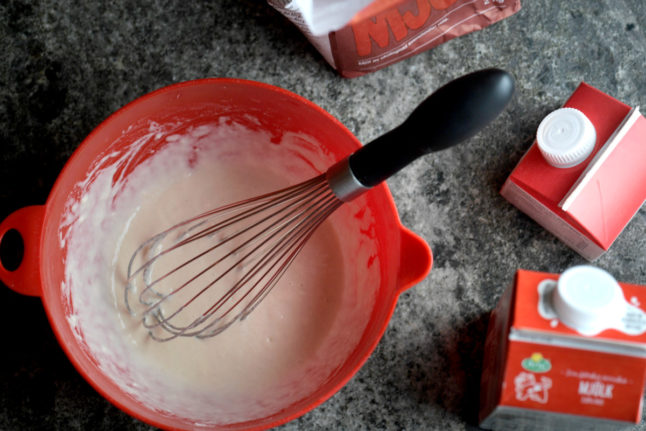Summary
Makes: 6-8
Level: Very Easy
Preparation: 5 minutes*
Cooking: 15 minutes
Total: 20 minutes
*Plus 30 minutes standing time
Tips
• Use a Swedish waffle iron if possible to get characteristic thin heart shapes.
• You can use the recipe below with a Belgian waffle iron, but it is better if you add a teaspoon of “instant” dried yeast with the dry ingredients (step 2 for egg waffles and step 3 for crispy waffles).
• In the case of the egg waffles, the mixture improves if it is rested for at least 30 minutes in a fridge before it is used. (For breakfast waffles the mixture can be rested in a fridge overnight.)
Ingredients for egg waffles
90g (3 oz) butter
200g (1½ cups) plain (all-purpose) flour
75g (⅓ cup) caster (superfine) sugar
¾ tsp baking powder
¾ tsp vanilla sugar
300 ml (1¼ cups) milk
1 egg, lightly beaten
Method for egg waffles
1. Melt the butter in a microwave or a saucepan, but don’t let it brown. Leave it to cool slightly.
2. Mix the dry ingredients in a bowl.
3. Gradually whisk in the milk and the melted butter.
4. Whisk in the beaten egg to form a smooth batter.
5. Leave the batter in the fridge for 30 minutes or overnight before frying.
6. Preheat your waffle iron. (Usually there is a pilot light which will go out when the waffle iron is up to temperature.)
7. Pour about 4-6 tablespoons of batter on the middle of the lower plate and close the lid. Press the lid for a few seconds so that the batter is spread evenly. (Do not press during the whole process as this will prevent the waffle from rising.)
8. Fry for about 1-2 minutes until the waffle is golden brown.
9. Serve the waffle while still hot.
READ ALSO: How to make Swedish gooseberry and elderflower compote
Ingredients for crispy waffles
30 g (2 tbsp) butter
240 ml (1 cup) whipping cream
125 g (1 cup) plain (all-purpose) flour, sifted
¾ tsp baking powder
Pinch salt
150 ml (10 tsbp) cold sparkling mineral water
Method for crispy waffles
1. Melt the butter in a microwave or a saucepan, but don’t let it brown. Leave it to cool slightly.
2. Whip the cream until it forms soft peaks.
3. Fold in the flour, baking powder and salt.
4. Add the cold sparkling water and then finally the melted butter. Mix to produce an even batter.
5. Preheat your waffle iron. (Usually there is a pilot light which will go out when the waffle iron is up to temperature.)
6. Pour about 4-6 tablespoons of batter on the middle of the lower plate and close the lid. Press the lid for a few seconds so that the batter is spread evenly. (Do not press during the whole process as this will prevent the waffle from rising.)
7. Fry for about 1-2 minutes until the waffle is golden brown.
8. Serve the waffle while still hot.
Serving suggestions
1. Jam and lightly whipped cream or ice cream is the most popular way of serving waffles.
2. Waffles are also nice with fresh fruit and cream. (If the fruit needs some sugar, use demerara sugar with crispy waffles.)
3. Waffles go really well with a blueberry or bilberry compote: rinse 150 g (5 oz) of berries (fresh or frozen) and add to a saucepan along with two tablespoons of caster (superfine) sugar. Simmer gently until the juice runs and they are beginning to soften, about 5 minutes. Leave to cool. Pour on top of the waffles, dust with ground cinnamon and add some lightly whipped cream or ice cream.
4. For a spicier blueberry compote: mix 200 g (7 oz) blueberries, 1 tablespoon of caster (superfine) sugar, 1 teaspoon of balsamic vinegar, a pinch of ground cinnamon and a pinch of ground cloves. Poach for about 5 minutes until soft and gooey and then increase the heat and boil for 4 minutes to thicken. Serve warm or cold with waffles and whipped cream or ice cream.
5. For a slightly more luxurious topping make some blåbärskräm (bilberry/blueberry cream): lightly whip 300 ml (1¼ cups) of whipping cream and mix with 2 tablespoons of icing sugar (powder sugar), ½ teaspoon of vanilla powder and 150 g (5 oz) of lightly cooked blueberries or bilberries. If you use blueberries sprinkle over some ground cinnamon when you serve the waffles. (For a more filling version, replace half of the whipped cream with mascarpone cheese.)
Recipe courtesy of John Duxbury, editor and founder of Swedish Food.



 Please whitelist us to continue reading.
Please whitelist us to continue reading.
Member comments